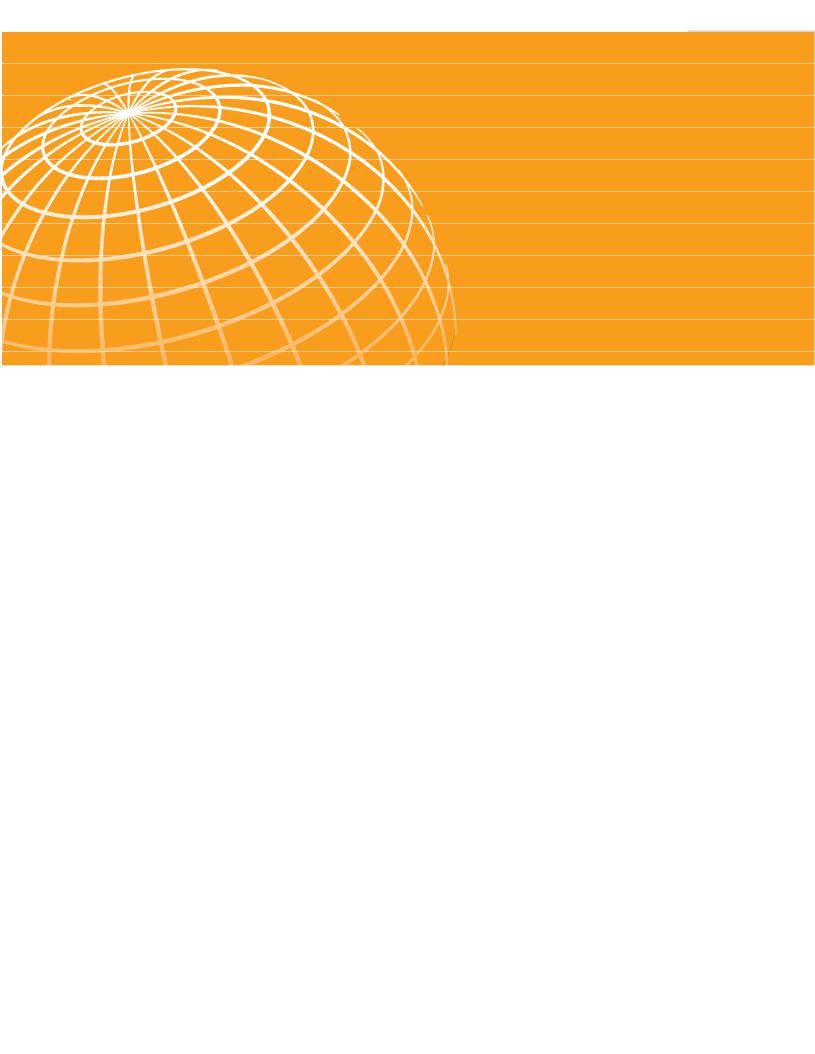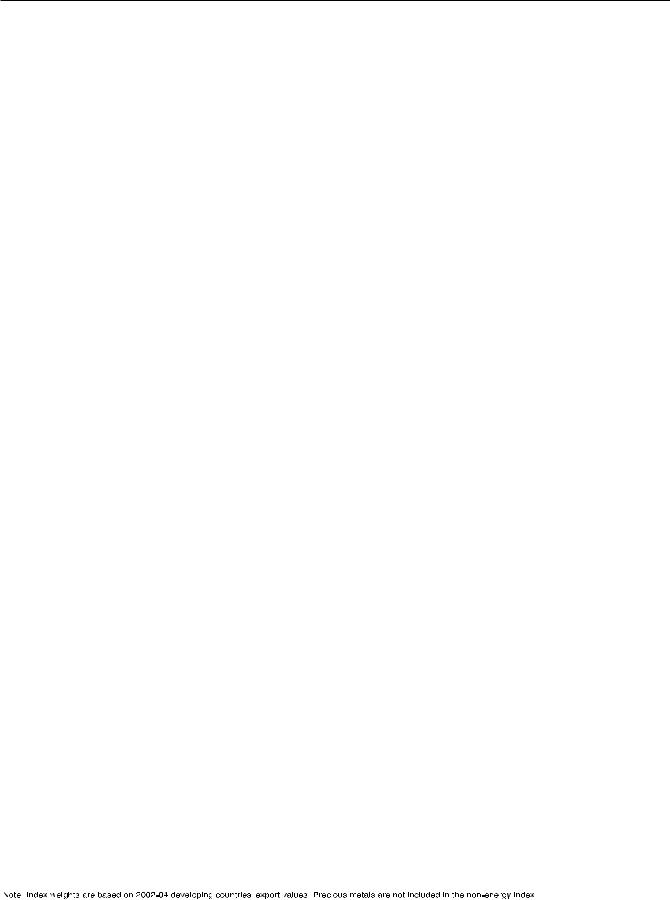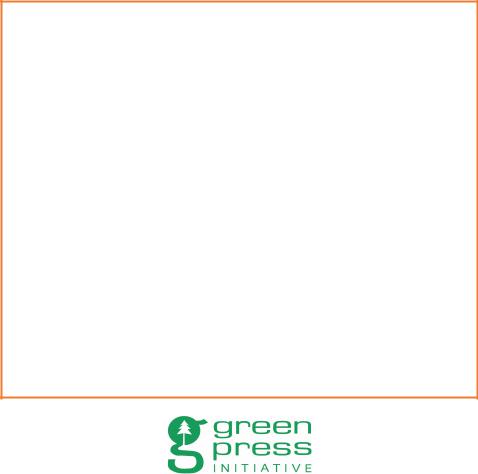
World Bank - Commodity Market Outlook_watermark
.pdf
vk.com/id446425943
APPENDIX C
Description of price series
Technical notes
vk.com/id446425943
vk.com/id446425943
C O M M O DI T Y M ARKE T S O U T LOO K | AP RI L 2 0 1 9 |
AP P E N DI X C |
75 |
|
|
|
Description of price series
Energy
Coal (Australia). Thermal, f.o.b. Newcastle, 6,000 kcal/kg, spot price.
Coal (South Africa). f.o.b Richards Bay, NAR, 6000 kcal/kg, sulfur less than 1%, forward month one.
Crude oil. Average price of Brent (38° API), Dubai Fateh (32° API), and West Texas Intermediate (WTI, 40° API). Equally weighed.
Natural Gas Index (Laspeyres). Weights based on five-year consumption volumes for Europe, U.S. and Japan (LNG), updated every five years.
Natural gas (Europe), Netherlands Title Transfer Facility (TTF).
Natural gas (U.S.). Spot price at Henry Hub, Louisiana.
Natural gas (Japan). LNG, import price, cif; recent two months' averages are estimates.
Non-Energy
Beverages
Cocoa (ICCO). International Cocoa Organisation daily price, average of the first three positions on the terminal markets of New York and London, nearest three future trading months.
Coffee (ICO). International Coffee Organization indicator price, other mild Arabicas, average New York and Bremen/Hamburg markets, ex-dock.
Coffee (ICO). International Coffee Organization indicator price, Robustas, average New York and Le Havre/Marseilles markets, ex-dock.
Tea. Average three auctions, arithmetic average of quotations at Kolkata, Colombo, and Mombasa/ Nairobi.
Tea (Colombo). Sri Lankan origin, all tea, arithmetic average of weekly quotes.
Tea (Kolkata). leaf, include excise duty, arithmetic average of weekly quotes.
Tea (Mombasa/Nairobi). African origin, all tea, arithmetic average of weekly quotes.
Oils and meals
Coconut oil (Philippines/Indonesia). crude, c.i.f. NW Europe.
Groundnuts (US), Runners 40/50, CFR N.W.
Europe
Groundnut oil. US crude, FOB South-East.
Fishmeal. German, 64% protein, EXW Hamburg.
Palm oil (Malaysia). RBD, c.i.f Rotterdam.
Palmkernel Oil (Indonesia/Malaysia). Crude, c.i.f. NW Europe.
Soybean meal. Brazilian pellets 48% protein, c.i.f Rotterdam.
Soybean oil. Dutch crude, degummed, f.o.b. NW Europe.
Soybeans. US No. 2 yellow meal, c.i.f. Rotterdam.
Grains
Barley (U.S.). Feed, No. 2, spot, 20-days-to- arrive, delivered Minneapolis.
Maize (U.S.). No. 2, yellow, f.o.b. US Gulf ports.
Rice (Thailand). 5% broken, white rice (WR), milled, indicative price based on weekly surveys of export transactions, government standard, f.o.b. Bangkok.
Rice (Thailand). 25% broken, WR, milled indicative survey price, government standard, f.o.b. Bangkok.
Rice (Thailand). 100% broken, A.1 Super, indicative survey price, government standard, f.o.b. Bangkok.
Rice (Vietnam). 5% broken, WR, milled, weekly indicative survey price, minimum export price, f.o.b. Hanoi.
Sorghum (U.S.). No. 2 milo yellow, f.o.b. Gulf ports.
Wheat (U.S.). No. 1, hard red winter (HRW),
vk.com/id446425943
76 |
AP P E N DI X C |
C O M M O DI T Y M ARKE T S O U T LOO K | AP RI L 2 0 1 9 |
|
|
|
|
|
ordinary protein, export price delivered at the US Gulf port for prompt or 30 days shipment.
Wheat (U.S.). No. 2, soft red winter (SRW), export price delivered at the U.S. Gulf port for prompt or 30 days shipment.
Other food
Bananas (Central and South America). Major brands, free on truck (f.o.t.) Southern Europe, including duties.
Bananas (Central and South America). Major brands, U.S. import price, f.o.t. U.S. Gulf ports.
Meat, beef (Australia/New Zealand). Chucks and cow forequarters, frozen boneless, 85% chemical lean, c.i.f. U.S. port (east coast), ex-dock.
Meat, chicken (U.S.). Urner Barry North East weighted average for broiler/fryer, whole birds, 2 - 1/2 to 3.5 pounds, USDA grade "A".
Meat, sheep (New Zealand). Frozen whole carcasses Prime Medium (PM) wholesale, Smithfield, London.
Oranges (Mediterranean exporters). Navel, EEC indicative import price, c.i.f. Paris.
Shrimp (U.S.). brown, shell-on, headless, in frozen blocks, source Gulf of Mexico, 26 to 30 count per pound, wholesale US.
Sugar (EU). European Union negotiated import price for raw unpackaged sugar from African, Caribbean, and Pacific (ACP), c.i.f. European ports.
Sugar (U.S.). Nearby futures contract, c.i.f.
Sugar (world). International Sugar Agreement (ISA) daily price, raw, f.o.b. and stowed at greater Caribbean ports.
Timber
Logs (West Africa). Sapele, high quality (loyal and marchand), 80 centimeter or more, f.o.b. Douala, Cameroon.
Logs (Southeast Asia). Meranti, Sarawak, Malaysia, sale price charged by importers, Tokyo.
Plywood (Africa and Southeast Asia). Lauan, 3- ply, extra, 91 cm x 182 cm x 4 mm, wholesale price, spot Tokyo.
Sawnwood (West Africa). Sapele, width 6 inches or more, length 6 feet or more, f.a.s. Cameroonian ports.
Sawnwood (Southeast Asia). Malaysian dark red seraya/meranti, select and better quality, average 7 to 8 inches; length average 12 to 14 inches; thickness 1 to 2 inches; kiln dry, c. & f. U.K. ports, with 5% agents commission including premium for products of certified sustainable forest.
Woodpulp (Sweden). Softwood, sulphate, bleached, air-dry weight, c.i.f. North Sea ports.
Other raw materials
Cotton (Cotlook “A” index). Middling 1-3/32 inch, traded in Far East, C/F.
Rubber (Asia). RSS3 grade, Singapore Commodity Exchange Ltd (SICOM) nearby contract.
Rubber (Asia). TSR 20, Technically Specified Rubber, SICOM nearby contract.
Fertilizers
DAP (diammonium phosphate), spot, f.o.b. U.S. Gulf.
Phosphate rock , f.o.b. North Africa.
Potassium chloride (muriate of potash), spot, f.o.b. Vancouver.
TSP (triple superphosphate), spot, import U.S. Gulf.
Urea (Ukraine), f.o.b. Black Sea.
Metals and minerals
Aluminum (LME). London Metal Exchange, unalloyed primary ingots, standard high grade, physical settlement.
Copper (LME). Standard grade A, cathodes and wire bar shapes, physical settlement.
vk.com/id446425943
C O M M O DI T Y M ARKE T S O U T LOO K | AP RI L 2 0 1 9 |
AP P E N DI X C |
77 |
|
|
|
Iron ore (any origin). Fines, spot price, c.f.r. China, 62% Fe.
Lead (LME). Refined, standard high grade, physical settlement.
Nickel (LME). Cathodes, standard high grade, physical settlement.
Tin (LME). Refined, standard high grade, physical settlement.
Zinc (LME). Refined, standard special high grade, physical settlement.
Precious Metals
Gold (U.K.). 99.5% fine, London afternoon fixing, average of daily rates.
Platinum (U.K.). 99.9% refined, London afternoon fixing.
Silver (U.K.). 99.9% refined, London afternoon fixing.
vk.com/id446425943
78 |
AP P E N DI X C |
C O M M O DI T Y M ARKE T S O U T LOO K | AP RI L 2 0 1 9 |
|
|
|
|
|
Technical Notes
Definitions and explanations
Constant prices are prices which are deNated by the Manufacturers Unit Value Index (MUV).
MUV is the unit value index in U.S. dollar terms of manufactures exported from Ofteen countries: Brazil, Canada, China, Germany, France, India, Italy, Japan, Mexico, Republic of Korea, South Africa, Spain, Qailand, the United Kingdom, and the United States.
Price indexes were computed by the Laspeyres formula. Qe Non-Energy Price Index is comprised of 34 commodities. U.S. dollar prices of each commodity is weighted by 2002-2004 average export values. Base year reference for all indexes is 2010. Countries included in indexes are all lowand middle-income, according to World Bank income classiOcations.
Price index weights. Trade data as of May 2008 comes from United Nations' Comtrade Database via the World Bank WITS system, Food and Agriculture Organization FAOSTAT Database, International Energy Agency Database, BP Statistical Review, World Metal Statistics, World Bureau of Metal Statistics, and World Bank staR estimates. Qe weights can be found in the table on the next page.
Reporting period. Calendar vs. crop or marketing year refers to the span of the year. It is common in many agricultural commodities to refer to production and other variables over a twelvemonth period that begins with harvest. A crop or marketing year will often diRer by commodity and, in some cases, by country or region.
Abbreviations
$ = U.S. dollar
bbl = barrel
bcf/d = billion cubic feet per day
c.i.f. = cost, insurance, freight
c.f.r. = cost and freight
cum = cubic meter
dmt = dry metric ton
f.o.b. = free on board f.o.t. = free on truck kg = kilogram
mb/d = million barrels per day mmbtu = million British thermal units mmt = million metric tons
mt = metric ton (1,000 kilograms)
mtoe = millions of tonnes of oil equivalent toz = troy ounce
Acronyms |
|
AEs |
advanced economies |
DAP |
diammonium phosphate |
EIA |
Energy Information Administration |
EU |
European Union |
EMDEs |
Emerging markets and developing |
|
economies |
FAO |
Food and Agriculture Organization |
FRED |
Federal Reserve Bank of St. Louis |
|
Economic Data |
GDP |
gross domestic product |
ICAC |
International Cotton Advisory |
|
Committee |
IEA |
International Energy Agency |
IFA |
International Fertilizer Industry |
|
Association |
IRSG |
International Rubber Study Group |
LME |
London Metal Exchange |
LNG |
liqueOed natural gas |
MOP |
muriate of potash, or potassium |
|
chloride |
MUV |
Manufacture Unit Value |
NGLs |
Natural gas liquids |
OECD |
Organisation of Economic Co- |
|
operation and Development |
OPEC |
Organization of the Petroleum |
|
Exporting Countries |
TSP |
triple superphosphate |
vk.com/id446425943
C O M M O DI T Y M ARKE T S O U T LOO K | AP RI L 2 0 1 9 |
AP P E N DI X C |
79 |
|
|
|
USDA |
United States Department of |
|
Agriculture |
WTI |
West Texas Intermediate |
Data sources
Africa Tea Brokers Limited Agribusiness Intelligence from Informa Banana Market Review
Baker Hughes
Bloomberg
BP Statistical Review
British Geological Survey
Cotton Outlook
Federal Reserve Bank of St. Louis Economic Data (FRED)
Food and Agriculture Organization (FAO)
Intergovernmental Group on Bananas and Tropical Fruits
Intergovernmental Group on Tea International Cocoa Organisation (ICCO) International CoRee Organization (ICO)
International Cotton Advisory Committee (ICAC)
International Energy Agency (IEA)
International Fertilizer Industry Association (IFA)
International Rubber Study Group (IRSG)
International Tropical Timber Organization (ITTO)
International Sugar Organization (ISO)
ISTA Mielke GmbH Oil World
Japan Lumber Journal
Kennedy Information LLC
Meat Trade Journal
Metallgesellschaft
OUcial Statistics of Japan
Platinum and Palladium Survey
Singapore Commodity Exchange Ltd
Steel Statistical Yearbook
Tea Board India
Tea Exporters Association Sri Lanka
Qomson Reuters
Urner Barry
U.S. Department of Agriculture (USDA)
U.S. Energy Information Administration (EIA)
U.S. Geological Survey
World Bureau of Metal Statistics

vk.com/id446425943
80 AP P E N DI X C C O M M O DI T Y M ARKE T S O U T LOO K | AP RI L 2 0 1 9
Weights for commodity price indexes
Commodity group |
Share of energy and non-energy indexes |
Share of sub-group indexes |
|
|
|
ENERGY |
100.0 |
100.0 |
|
|
|
Coal |
4.7 |
4.7 |
Crude Oil |
84.6 |
84.6 |
|
|
|
Natural Gas |
10.8 |
10.8 |
NON-ENERGY |
100.0 |
|
|
|
|
Agriculture |
64.9 |
|
Beverages |
8.4 |
100.0 |
|
|
|
Coffee |
3.8 |
45.7 |
Cocoa |
3.1 |
36.9 |
|
|
|
Tea |
1.5 |
17.4 |
Food |
40.0 |
|
|
|
|
Grains |
11.3 |
100.0 |
Rice |
3.4 |
30.1 |
|
|
|
Wheat |
2.8 |
25.2 |
Maize (includes sorghum) |
4.6 |
40.7 |
|
|
|
Barley |
0.5 |
4.1 |
Oils and meals |
16.3 |
100.0 |
|
|
|
Soybeans |
4.0 |
24.6 |
Soybean Oil |
2.1 |
13.0 |
|
|
|
Soybean Meal |
4.3 |
26.3 |
Palm Oil |
4.9 |
30.2 |
|
|
|
Coconut Oil |
0.5 |
3.1 |
Groundnut Oil (includes groundnuts) |
0.5 |
2.8 |
|
|
|
Other food |
12.4 |
100.0 |
Sugar |
3.9 |
31.5 |
|
|
|
Bananas |
1.9 |
15.7 |
Meat, beef |
2.7 |
22.0 |
|
|
|
Meat, chicken |
2.4 |
19.2 |
Oranges (includes orange junice) |
1.4 |
11.6 |
|
|
|
Agricultural Raw Materials |
16.5 |
|
Timber |
8.6 |
100.0 |
|
|
|
Logs |
1.9 |
22.1 |
Sawnwood |
6.7 |
77.9 |
|
|
|
Other Raw Materials |
7.9 |
100.0 |
Cotton |
1.9 |
24.7 |
|
|
|
Natural Rubber |
3.7 |
46.7 |
Tobacco |
2.3 |
28.7 |
|
|
|
Fertilizers |
3.6 |
100.0 |
Natural Phosphate Rock |
0.6 |
16.9 |
|
|
|
Phosphate |
0.8 |
21.7 |
Potassium |
0.7 |
20.1 |
|
|
|
Nitogenous |
1.5 |
41.3 |
Metals and Minerals |
31.6 |
100.0 |
|
|
|
Aluminum |
8.4 |
26.7 |
Copper |
12.1 |
38.4 |
|
|
|
Iron Ore |
6.0 |
18.9 |
Lead |
0.6 |
1.8 |
|
|
|
Nickel |
2.5 |
8.1 |
Tin |
0.7 |
2.1 |
|
|
|
Zinc |
1.3 |
4.1 |
PRECIOUS METALS |
100.0 |
|
|
|
|
Gold |
77.8 |
|
Silver |
18.9 |
|
|
|
|
Platinum |
3.3 |
|
|
|
|

vk.com/id446425943
C O M M O DI T Y M ARKE T S O U T LOO K | AP RI L 2 0 1 9 AP P E N DI X C 81
Commodity Markets Outlook: Selected Topics, 2011-18
Topics |
Date |
|
|
Food Price Shocks: Channels and Implications |
April 2019 |
|
|
The implications of tariffs for commodity markets |
October 2018 |
|
|
The changing of the guard: Shifts in commodity demand |
October 2018 |
|
|
Oil exporters: Policies and challenges |
April 2018 |
|
|
Investment weakness in commodity exporters |
January 2017 |
|
|
OPEC in historical context: Commodity agreements and market fundamentals |
October 2016 |
|
|
From energy prices to food prices: Moving in tandem? |
July 2016 |
|
|
Resource development in era of cheap commodities |
April 2016 |
|
|
Weak growth in emerging market economies: What does it imply for commodity markets? |
January 2016 |
|
|
Understanding El Niño: What does it mean for commodity markets? |
October 2015 |
|
|
Iran nuclear agreement: A game changer for energy markets? |
October 2015 |
|
|
How important are China and India in global commodity consumption? |
July 2015 |
|
|
Anatomy of the last four oil price crashes |
April 2015 |
|
|
Oil price plunge in perspective |
January 2015 |
|
|
The role of income growth in commodities |
October 2014 |
|
|
Price volatility for most commodities has returned to historical norms |
July 2014 |
|
|
The nature and causes of oil price volatility |
January 2014 |
|
|
A global energy market? |
July 2013 |
|
|
Global reserves, demand growth, and the “super cycle” hypothesis |
July 2013 |
|
|
The “energy revolution,” innovation, and the nature of substitution |
January 2013 |
|
|
Commodity prices: levels, volatility, and comovement |
January 2013 |
|
|
Which drivers matter most in food price movements? |
January 2013 |
|
|
Induced innovation, price divergence, and substitution |
June 2012 |
|
|
The role of emerging markets in commodity consumption |
June 2012 |
|
|
WTI-Brent price dislocation |
January 2012 |
|
|
Metals consumption in China and India |
January 2012 |
|
|
China, global metal demand, and the super-cycle hypothesis |
June 2011 |
|
|

vk.com/id446425943
ECO-AUDIT
Environmental Benefits Statement
The World Bank Group is committed to reducing its environmental footprint. In support of this commitment, we leverage electronic publishing options and print-on-demand technology, which is located in regional hubs worldwide. Together, these initiatives enable print runs to be lowered and shipping distances decreased, resulting in reduced paper consumption, chemical use, greenhouse gas emissions, and waste.
We follow the recommended standards for paper use set by the Green Press Initiative. The majority of our books are printed on Forest Stewardship Council (FSC)-certified paper, with nearly all containing 50-100 percent recycled content. The recycled fiber in our book paper is either unbleached or bleached using totally chlorine-free (TCF), processed chlorine-free (PCF), or enhanced elemental chlorine-free (EECF) processes.
More information about the Bank’s environmental philosophy can be found at
http://www.worldbank.org/corporateresponsibility.
